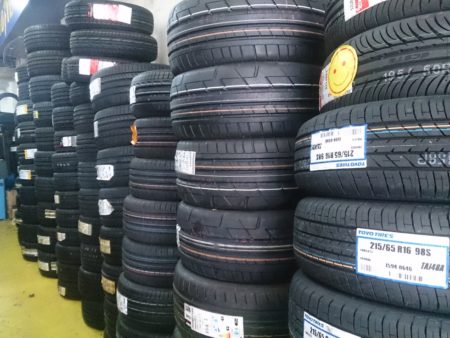Depending on who you ask everyone will have their own opinion on what kind of tire is best. If you’re getting a used tire, if you’re getting a new tire, or if you’re even getting tires for free from a used dealership. With every tire comes a different drifting experience, and with every car comes a different power level to push those tires. But are tires. Really? What’s most important? And if so, which type of Tire should you be running on?
If you are new to drifting, the odds are you should be running on some of the cheapest tires, or the ones that you can get the most seat time with. If you have some experience drifting, you can choose between using free/cheap tires and getting more seat time, or using expensive tires and getting better performance.
However, skill levels aren’t the only thing that dictates which tire you should use. Engine power, forced induction, and suspension geometry all affect your tire choice as well.
When Should You Drift On Free Tires?
 Drifting on free tires is mostly for the new drifter, someone who is unsure whether they want to take up drifting as a hobby. This can help lower their costs, and prevent them from burning their only good set of tires.
Drifting on free tires is mostly for the new drifter, someone who is unsure whether they want to take up drifting as a hobby. This can help lower their costs, and prevent them from burning their only good set of tires.
Another drifter that I’d recommend running free tires with is the one who knows they like drifting, but doesn’t have the money to spare for tires. If you fall in this category, that’s perfectly okay! I was in this category too for a short time, and if it weren’t for the free tires, I would’ve lost out on a lot of seat time!
How To Get Free Tires?
Well, tire dealerships have to get rid of the tires they take off cars. When they do so, they’re charged per tire they dispose of. If you come into the picture, and offer to take those tires off their hands for free (the usable ones in your size at least), that’s a win-win.
Their main objection to this idea will be liability. If they give these tires to you and mount them, and you crash due to those tires? The shop could be seen as at fault for mounting bad tires. If you tell the shop they’ll be for “track use only”, and that you’re just “burning them off”, they can’t object anymore. They don’t have a logical counter-argument, so most of the time, you’ll get the tires for free!
This mainly works on small, mom ‘n’ pop shops, as larger chains are more wary of deals like this. They also receive funding based on how many tires they dispose of. Contrary to a small shop, chains actually get paid to dispose of tires, usually.
NOTE THE SIDEBAR, I do not condone any illegal activities. This article is strictly for informative purposes.
If you’re not a charismatic person, or just don’t want to talk to other people, there’s another way. However, I don’t promote this option. Most tire or auto shops have a dumpster out back, where the garbage tires are put to be disposed of. If you can locate this, and it isn’t locked, you have access to their trash tires. While these tires are trash, this is still stealing, and I do NOT condone stealing. You do so at your own risk.
Getting tires for free is a concept not many realize is easy. Really, the hardest part of the process is making friends with the tire shops near you. While this method won’t get you the highest-quality tires, or the same ones consistently, this will get you behind the wheel for cheaper, and for a grassroots drifter, seat time is king.
When Should You Drift On Used Tires?
 Getting free tires is nice, but it can be unreliable at times. If you’re going to be drifting consistently, you’ll need a more consistent method of getting tires. This can come in the form of, rather than chancing the shop trashing your size tire, buying their used tires.
Getting free tires is nice, but it can be unreliable at times. If you’re going to be drifting consistently, you’ll need a more consistent method of getting tires. This can come in the form of, rather than chancing the shop trashing your size tire, buying their used tires.
Generally, you’ll be getting more life out of these than from the free tires. If the tire is salable, then it will have a decent amount of rubber on it. Depending on your car, you can get anywhere from 5 to 50 laps on a set of used tires. While those are the extreme numbers, you’re most likely to get roughly 20 per set.
If you’re in a position that you love drifting, but don’t have the money to keep buying new tires, you should be drifting used tires. If you’re just getting into drifting, but don’t want to run the risk of free tires, you should be drifting used tires.
Looking at Used Tires
When you’re in the shop, looking at used tires, you should look for three main things. One, making sure the tire’s size will fit in your car. Not just the rim size, but the clearance to your fender and inner wheel-well liner.
Second, keep your eyes out for dry rot. This can be an issue with tires, depending on where you go. Most high-profile shops won’t have rotted tires for fear of ruining their reputation. Lower-end shops, however, may well less-than-perfect tires on their racks. Be sure you’re looking very closely for rot, and while you’re at it…
Third, be watching for punctures or tears in the tire. Just because the tire is on the shelf doesn’t guarantee that it’ll work for you, or even inflate. Go over that tire with a fine-toothed comb before you buy it, as if you buy a damaged tire from a shop, they may operate on a no-return policy.
When Should You Drift On New Tires?
 Drifting on new tires isn’t for the faint of heart. These bad boys can run anywhere from $50 per tire, all the way up to $300+ (trust me, I’d know. My ’87 944 cost me $1,000 for a full set of tires). That’s not even taking the tire compound into effect, that’s just based on size.
Drifting on new tires isn’t for the faint of heart. These bad boys can run anywhere from $50 per tire, all the way up to $300+ (trust me, I’d know. My ’87 944 cost me $1,000 for a full set of tires). That’s not even taking the tire compound into effect, that’s just based on size.
The person who drifts on new tires is someone with a lot of experience. They already know how to handle their car, and they need the extra grip these tires give. They can also feel how different tires affect their driving and responsiveness. This drifter will generally buy one type of tire, and not switch, so they have the same feel every time. Consistency is what they need, especially when they’re drifting tandem.
If you can afford to buy new tires for drifting, then you can afford to be picky with them as well. The tread pattern, tread wear rating, and sidewall strength can all affect your drifting experiences. When you’re first starting to buy new tires, try different brands, patterns, and wear ratings. Feel out which tire you drift best on, and go from there. Forums will also be a big help in narrowing your selection. Asking others that drift the same platform as you what tires they run will give you the initial list of tires to try.
Overall
Being a drifter isn’t a cheap hobby. Between fuel, maintenance, and tires, your wallet is bound to be hurting after every event. We have a whole breakdown of the costs of drifting on the site. Being able to lighten the load by using lower quality tires certainly helps, but you have to be able to gauge for yourself whether it’s worth the performance loss!

